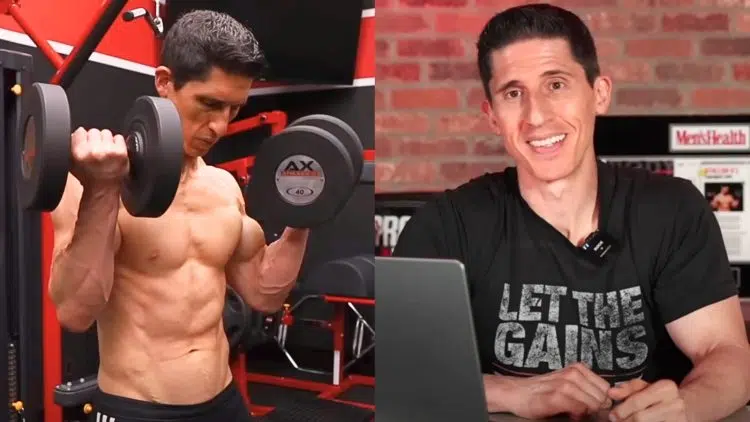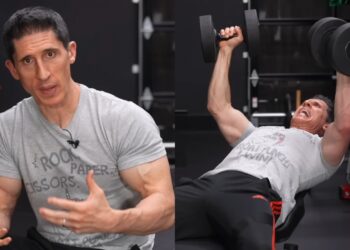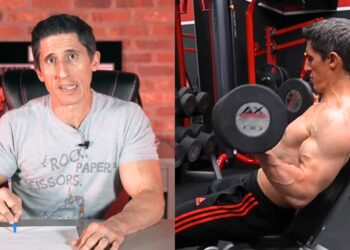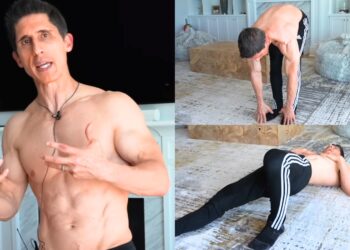Veteran fitness coach Jeff Cavaliere believes it’s time to stop performing the typical three sets of 12 repetitions. Taking to his latest YouTube video, Jeff Cavaliere discussed muscle building and why you shouldn’t let sets and reps guide your workouts.
“Stop letting sets and reps be the guiding factor. It’s a big mistake when it’s all about sets and reps first, and then you’re like adapting your effort to the sets and reps.”
In addition to his merit as a prominent fitness trainer, Cavaliere has helped shape high-profile athletes from around the world. In Major League Baseball, he served as the head physical therapist and assistant strength and conditioning coach to the New York Metts.
While multiple sets of 12 reps have been popularized by bodybuilding legends like former four-time Mr. Olympia Jay Cutler, Cavaliere contends that there are greater options out there. Below, he laid out why you should put an end to this traditional set and rep range, and adjust your workouts to better accommodate muscle growth.
Jeff Cavaliere Says Stop Doing 3 Sets of 12 Reps, Discusses ‘Balls-Out To-Failure Approach’
View this post on InstagramGet Fitter, FasterLevel Up Your Fitness: Join our 💪 strong community in Fitness Volt Newsletter. Get daily inspiration, expert-backed workouts, nutrition tips, the latest in strength sports, and the support you need to reach your goals. Subscribe for free!
Before diving into ideal set and rep ranges, Cavaliere says understanding your physique goals plays a role in how you should train:
“Are we doing too many sets and reps? Well, let’s talk about it. So first of all, you got to ask yourself what is your goal. Because it has to all start from a goal.
Most people have a goal of building muscle I’d say that’s predominantly why people want to lift weights but there are others who are pursuing strength with a priority or they are athletes trying to improve performance or they are trying to improve endurance, in all of those cases, none of these would be the proper recommendation for me.”
Examining the late Mike Mentzer‘s to-failure training philosophy of one set, Cavaliere opened up on its validity.
“I think there’s a lot of merit to that. When Mike trained, he was advocating extremely high-intensity effort. The reason why you could do one set in heavy-duty style training was because the effort level was something of which you really don’t ever put forth in any other workout. It’s high high high effort. The highest effort you could exert,” says Jeff Cavaliere.
According to Cavaliere, it’s more effective to start with one set and work your way up rather than start with several, which could affect intensity.
“There’s always a place as Mike would say that you can go from there is up. If one didn’t work, you know where to go, you go to two, or you go to three or maybe four, but you don’t know, if you start at eight sets and you’re not really getting the results, do you go up to nine or down to seven, do you go down to six? Do you go down to five? Do you go up to 12?”
“I’m just throwing it out there as an effective place for people to start when they are trying to determine how many sets is right for me.”
Next, Cavaliere examined the ‘right’ repetition range and outlined the effort needed for a ‘balls-out to-failure’ training approach.
“That is a hell of a lot more broad than we once thought. It doesn’t necessarily have to be in a specific range, 8-12 for hypertrophy. Or 3-5 for strength, look, those seeking hypertrophy you can do it at many different rep ranges.
As of matter of fact, you could do it all the way up to 25 repetitions, 30 repetitions, but guess what’s needed there, you need to be able to deliver that balls-out-to-failure approach to training in order to create the stimulus that gives you that minimal effective dose.”
Also of note, Cavaliere says the range of motion can affect the quality of each repetition.
“How we do our repetitions, not just how many repetitions and how many sets, but what about the consideration to how you’re doing your repetitions and there’s a lot of focus right now being placed on the minimal range of motion, the stretch position of an exercise, and I’ve gone into this in another video.”
“We’re going to find that there’s a lot to learn and a lot of what’s being said right now is an incomplete picture.”
Muscle building and training performance remain among Cavaliere’s top priorities. He joined neuroscientist Dr. Andrew Huberman to discuss the most effective training splits. Overall, Cavaliere credited them all for having value but underscored that the training split you’ll stick with is best, just as long as you’re making progress.
Coaching athletes and fans alike for years, Cavaliere remains a trusted resource in fitness. He believes effort and intensity are the cornerstones of an effective training program, cautioning against letting reps and sets guide your workouts.
RELATED: Jeff Cavaliere On Sam Sulek’s Rise: “He’s A Brock Lesnar Of Bodybuilding”









